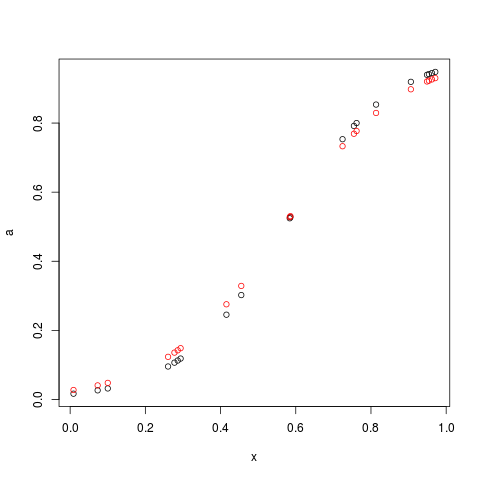Supported by Dr. Osamu Ogasawara and  providing providing  . . |
|
Last data update: 2014.03.03 |
Function performing the indirect calibrationDescriptionindirectCalibration is a function for the indirect calibration procedure as described by Ragin (2008). It uses a binomial or a beta regression for tranforming raw scores into calibrated scores. In our opinion, using a fractional polynomial may not be appropriate to this case. In fact, we do not deal with proportions. This function requires the package UsageindirectCalibration(x, x_cal, binom = TRUE) Arguments
ValueIt returns a vector of indirectly calibrated values. Author(s)Mario Quaranta ReferencesRagin, C. C. (2008) Redesigning Social Inquiry: Fuzzy Sets and Beyond, The Chicago University Press: Chicago and London. Schneider, C. Q., Wagemann, C. (2012) Set-Theoretic Methods for the Social Sciences, Cambridge University Press: Cambridge. Schneider, C. Q., Wagemann, C., Quaranta, M. (2012) How To... Use Software for Set-Theoretic Analysis. Online Appendix to "Set-Theoretic Methods for the Social Sciences". Available at www.cambridge.org/schneider-wagemann Examples# Generate fake data set.seed(4) x <- runif(20, 0, 1) # Find quantiles quant <- quantile(x, c(.2, .4, .5, .6, .8)) # Theoretical calibration x_cal <- NA x_cal[x <= quant[1]] <- 0 x_cal[x > quant[1] & x <= quant[2]] <- .2 x_cal[x > quant[2] & x <= quant[3]] <- .4 x_cal[x > quant[3] & x <= quant[4]] <- .6 x_cal[x > quant[4] & x <= quant[5]] <- .8 x_cal[x > quant[5]] <- 1 x_cal # Indirect calibration (binomial) a <- indirectCalibration(x, x_cal, binom = TRUE) # Indirect calibration (beta regression) b <- indirectCalibration(x, x_cal, binom = FALSE) # Correlation cor(a, b) # Plot plot(x, a); points(x, b, col = "red") Results
R version 3.3.1 (2016-06-21) -- "Bug in Your Hair"
Copyright (C) 2016 The R Foundation for Statistical Computing
Platform: x86_64-pc-linux-gnu (64-bit)
R is free software and comes with ABSOLUTELY NO WARRANTY.
You are welcome to redistribute it under certain conditions.
Type 'license()' or 'licence()' for distribution details.
R is a collaborative project with many contributors.
Type 'contributors()' for more information and
'citation()' on how to cite R or R packages in publications.
Type 'demo()' for some demos, 'help()' for on-line help, or
'help.start()' for an HTML browser interface to help.
Type 'q()' to quit R.
> library(SetMethods)
Loading required package: lattice
Loading required package: betareg
> png(filename="/home/ddbj/snapshot/RGM3/R_CC/result/SetMethods/indirectCalibration.Rd_%03d_medium.png", width=480, height=480)
> ### Name: indirectCalibration
> ### Title: Function performing the indirect calibration
> ### Aliases: indirectCalibration
>
> ### ** Examples
>
>
> # Generate fake data
> set.seed(4)
> x <- runif(20, 0, 1)
>
> # Find quantiles
> quant <- quantile(x, c(.2, .4, .5, .6, .8))
>
> # Theoretical calibration
> x_cal <- NA
> x_cal[x <= quant[1]] <- 0
> x_cal[x > quant[1] & x <= quant[2]] <- .2
> x_cal[x > quant[2] & x <= quant[3]] <- .4
> x_cal[x > quant[3] & x <= quant[4]] <- .6
> x_cal[x > quant[4] & x <= quant[5]] <- .8
> x_cal[x > quant[5]] <- 1
> x_cal
[1] 0.6 0.0 0.2 0.2 0.8 0.0 0.6 0.8 1.0 0.0 0.8 0.2 0.0 1.0 0.2 0.4 1.0 0.4 1.0
[20] 0.8
>
> # Indirect calibration (binomial)
> a <- indirectCalibration(x, x_cal, binom = TRUE)
>
> # Indirect calibration (beta regression)
> b <- indirectCalibration(x, x_cal, binom = FALSE)
>
> # Correlation
> cor(a, b)
[1] 0.9996942
>
> # Plot
> plot(x, a); points(x, b, col = "red")
>
>
>
>
>
> dev.off()
null device
1
>
|
